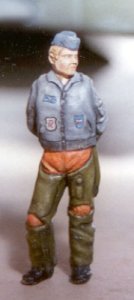Painting Leather
By John Wilkes
I personally use oil paints as they stay wet longer and can be blended, they can also be mixed with Humbrol enamel (this slows down the drying time of the enamel and makes it easier to avoid brush marks in the finished model). There is also a product called Linseed Oil which when added to oils slows down the drying even more. If you need to speed things up then add some Liquin from Windsor and Newton, this has a down side in that it drastically thins the paint making some of the more translucent colours even harder to apply as a solid colour. Now that I've given some pointers for oil painting I'll try to give some pointers to painting leather.

First paint the area to be leather a dark grey, matt or satin enamel is probably best. Once this has had enough time to dry say perhaps two days you can do the fun part. Get some black oil paint and add the tiniest amount of white oil and mix the two together. This must be a darker colour than the original enamel grey. Take the oil mix and put it onto a piece of cardboard (a Post-it will do very well) leave it for about twenty minutes, when you go back to it you will notice that the oil has been soaked up by the card and left mostly pigment behind. This is what you are after. Use this thick paint and liberally paint the area of leather. Leave it on the model for about twenty minutes and when you come back do the following. With a piece of kitchen towel or old rag gently wipe over the surface to take just the high area paint away revealing the grey underneath (do not have any thinners on the rag), the grey will also be stained and will appear slightly darker than the original colour. This will take practice and patience. I would also suggest masking the flesh and other areas that you have already painted. To give an old leather worn effect try a dark brown instead of the grey. You could even add some brown to the final colour to give a different effect. The same could be done with brown leather starting with a medium brown undercoat.
The whole thing now needs time to dry. I would suggest about two to three days before you start to handle the finished leather, remember that it takes time for oils to dry so they are prone to pick up dust while they dry so keep the painted item in a dust free environment. I use an old ice cream tub. At this stage you need to think about protecting the masterpiece from damage. I personally find that a coat of Johnsons Klear Acrylic Floor Polish works well followed by any matt, satin or gloss coat you want. Don't put oil based varnish or clear coats on the oil paint it may soak into the paint and ruin your hard work. All of this may sound daunting but it is very easy and you will be surprised at the results, several years of experience have taught me this technique and I've done it several times on different models including ejector seats, leather jackets, boots, belts, and anything leather.
© John Wilkes 2002
This article was published on Friday, October 30 2015; Last modified on Friday, October 30 2015
